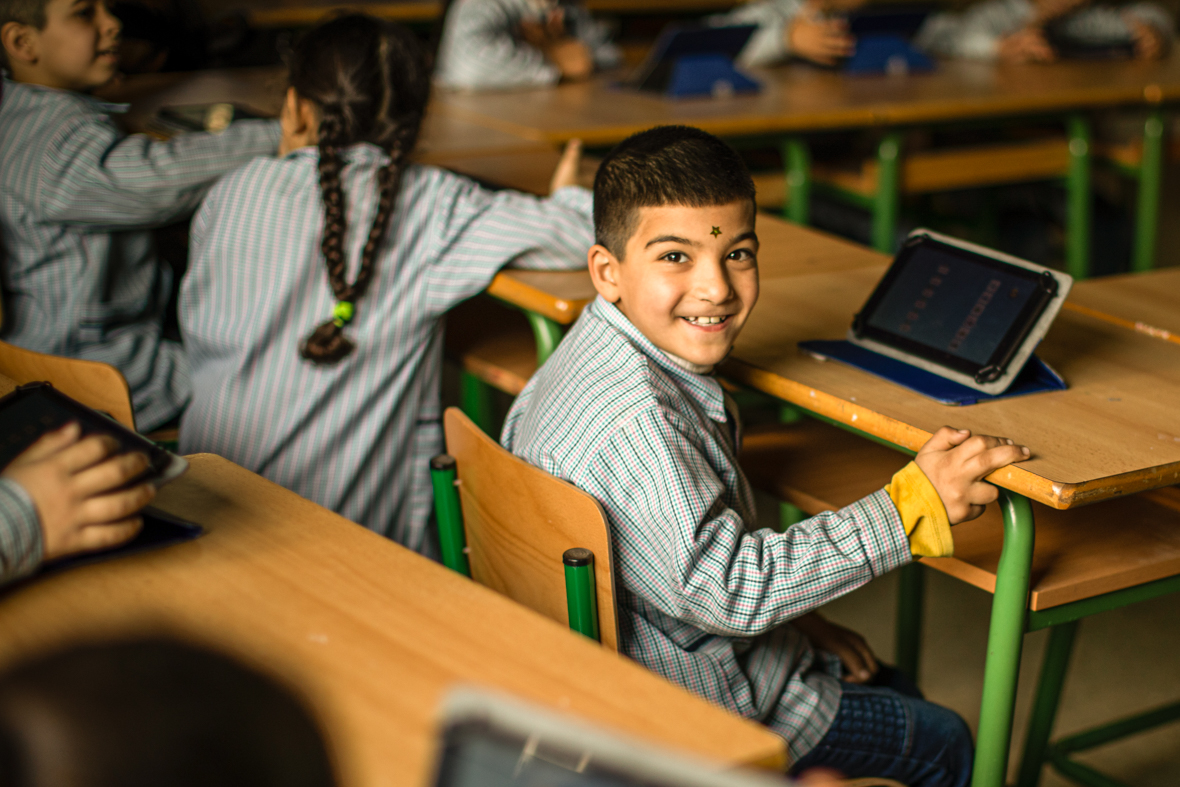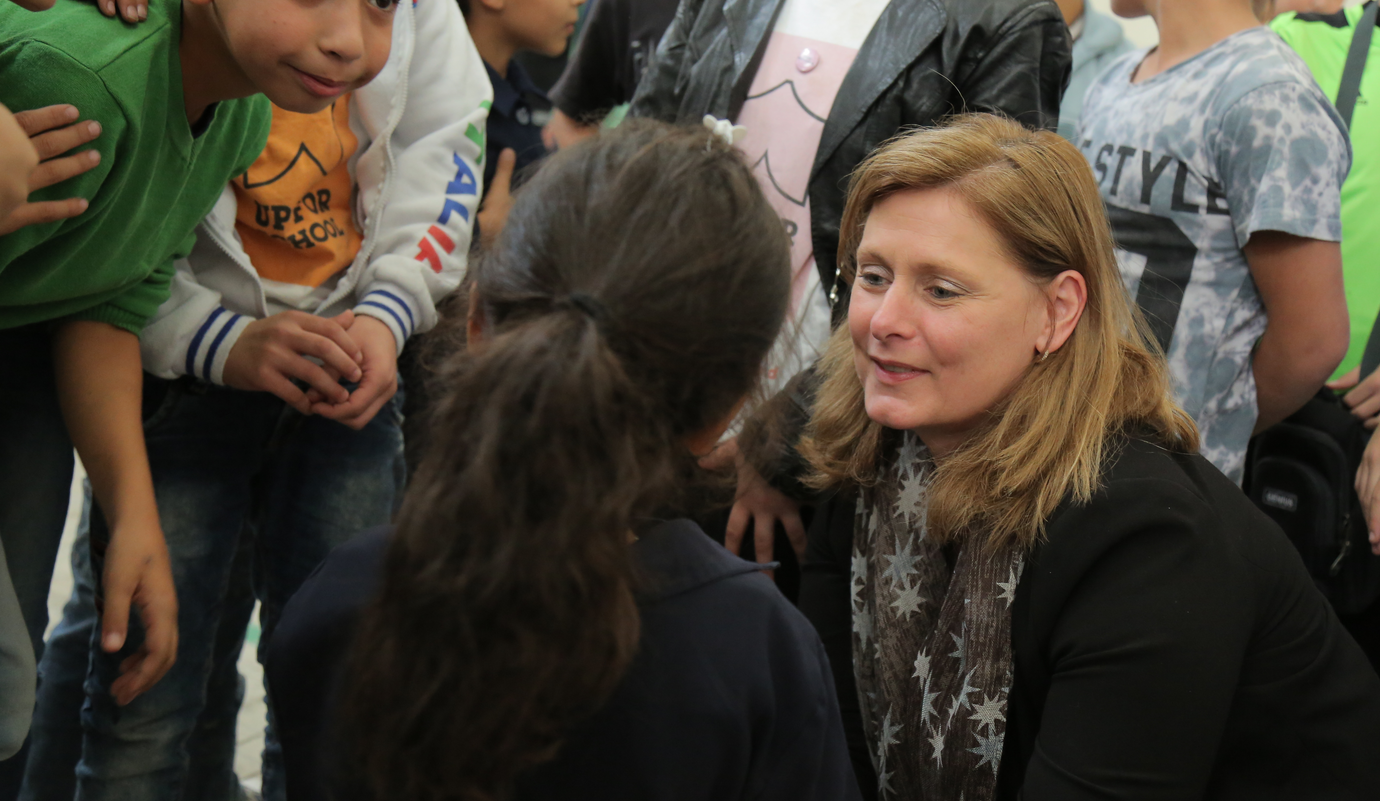
Education Commission launches bold plan to get every child in school by 2030
Education funding
Samina at a refugee village for Afghans in Kot Chandana village, Pakistan where Hansen Refugee Award winner Aqeela Asif founded schools for girls Picture: UNHCR/Duniya Aslam Khan
Bold action and radical funding could see every child in the world in school by 2030 – and avoid a looming global education catastrophe.
The high-powered Education Commission today delivered a plan called The Learning Generation to give a quality primary and secondary education to every girl and boy in every country.
But the commission also handed out a wake-up call to world leaders meeting at the United Nations General Assembly this week. It warned that global education is in a critical state and the next generation will be robbed of their future unless reform and major investment happens quickly.
Gordon Brown, commission chair and UN Special Envoy for Global Education, said at the UN launch: “Delivering high standards of education to millions who lose out is the civil rights struggle of our generation. The evidence before the commission proves education is the best anti-poverty investment the world can make.
“I am confident that if we combine investment and reform, and mobilise domestic and international finance in a more coordinated way, we can be the first generation in history in which every single child is at school.”
Education Commission report: reaching the 75m children living in emergencies
Education Commission report: preschool and early learning vital for every child
The commission – a distinguished group of global leaders, academics, business leaders and economists – unveiled The Learning Generation report after a year of research, consultations and analysis.
It said its proposed measures will increase the number of qualified high school graduates in low and middle-income countries from 400 million to 850 million by 2030 and to 1.2 billion by 2040. The numbers in the lowest income countries will rise from just eight million to 80 million.
The overall aid needed would be just $35 per child – less than $1 per week by 2030 – to get countries back on track for universal learning.
The in-depth report, comprising analysis and research from more than 300 partners in 105 countries, examined the current picture. It said:
- 263 million children and young people around the world are out of school
- About 75 million school-age children each year are directly affected by a humanitarian crisis such as a conflict or natural disaster
- One million Syrian refugee children are out of school – and most of those who are in school will drop out before starting secondary education
- More than 260 million children are out of school in low- and middle-income countries – an increase of 7% since 2010
- Twice as many girls as boys will never start school
- Fewer than one in 20 poor, rural girls in sub-Saharan Africa are on track to complete secondary school
- Half of the estimated 65 million children (primary and lower secondary age) with disabilities in developing countries are out of school.
- Only half of primary school children and just over a quarter of secondary school children in low- and middle-income countries are learning basic skills
It forcecast that, on current trends, by 2030:
- 825 million children in low and middle-income countries, half of the world’s 1.6 billion children, will not get the basic secondary-level skills they need for the jobs market
- 228 million children will not be in school
- 400 million will leave school without primary level qualifications
- Without urgent action, more than 1.5 billion adults will have no education beyond primary school in 2030 – and that will have dire consequences for inequality and instability across the world
Among those hundreds of millions set to miss out on education are children falling prey to child labour, child marriage and trafficking who are robbed of their basic rights. About 150 million children under 14 are child labourers and shut out of school, exposing them to violence and trafficking.
One in three girls in the developing world is married before the age of 18 and one in nine girls is married before the age of 15.
The report also warns of a serious threat to security in the Middle East, East-Indian sub-continent and Africa if children and young people are left without skills or on the streets without a chance of education and employment.
Erna Solberg, Norwegian Prime Minister and commission co-convener, said: “The imperative to get all children and young people learning is shared by all countries. All countries will gain from action and all will face the dangerous consequences of inaction.
“Evidence shows that when youth have equal access to education and employment opportunities the risk of engaging in extremist activities are lower. This is a time of opportunity but that time is running out.”
The Education Commission report – full title The Learning Generation: investing in education for a changing world – is an in-depth, 176-page examination of the issues, obstacles, statistics, budgets and potential solutions to the crisis.
Here is some background and a breakdown of key elements. You can read the full report here.
THE EDUCATION COMMISSION
Launched in September last year, its remit was to examine how to reverse the lack of financing for education around the world. It has been exploring how – over the next 15 to 20 years – education could lead to greater economic growth, better health outcomes and improved global security.
UN Secretary-General Ban Ki-moon has said the commission’s recommendations will be carried out. Learn more about the commission here.
Syrian family at a shelter for displaced people in Latakia Picture: UNHCR/Andrew McConnell
THE LEARNING GENERATION VISION
Achieving the Learning Generation means all children in low- and middle-income countries would have access to quality pre-primary, primary and secondary education within a generation.
It also means a child in a low-income country would be as likely to reach the accepted level of secondary school skills and take part in post-secondary education as a child in a high-income country today.
THE CONSEQUENCES OF FAILURE
If the world fails to get all children in school and learning, then by 2050:
- GDP per capita in low-income countries will be almost 70% lower than it would be if all children were learning – low-income countries alone will lose $1.8 trillion
- The number of lives lost each year because of lower levels of education will equal those lost today to HIV/AIDS and malaria – two of the most deadly global diseases
- Population growth will be at least 15% higher than if all children were learning – more than a quarter of the population in low-income countries will be living in extreme poverty
Up to half of today’s jobs – around two billion – are at high risk of disappearing due to automation by 2030. That means children must have the skills needed to get into the future workforce.
THE HEALTH BENEFITS OF EDUCATION
Higher levels of education, especially girls’ education, have significant impacts on life expectancy and mortality. Female schooling resulted in 30 million child deaths and 100 million adult deaths being avoided between 1970 and 2010.
Children sit in the burned ruins of school in Malaka, South Sudan, that was destroyed in fighting in February Picture: UNICEF/George
Birth rates among adolescent girls reduce if they stay in school longer. A child whose mother can read is 50% more likely to live past the age of five, 50% more likely to be immunised and twice as likely to attend school.
Each extra year of schooling reduces an adolescent boy’s risk of becoming involved in conflict by 20%.
ACTIONS TO ACHIEVE THE LEARNING GENERATION
The report proposes a four-stage plan.
STAGE ONE: All countries to adopt the reforms of the fastest improvers – the 25% of education performers around the world. Instead of only one in 10 schools being online, all schools would go digital.
STAGE TWO: Every country to see education as an investment in the future and raise spending in low-income countries from 3% of national income today to 5% of national income.
STAGE THREE: Mobilise the combined resources of the international institutions. No country committed to reforming and investing should be denied the chance to deliver universal education due to lack of funds.
STAGE FOUR: A “Financing Compact” between developing countries, donors and multilateral institutions – under which overall aid will rise to $35 a year per child by 2030, significantly less than $1 a week.
HOW IT WILL BE FUNDED
The commission says low- and middle-income countries will need to increase domestic spending on education from about $1 trillion in 2015 to $2.7 trillion by 2030, or from 4% to 5.8% of GDP.
International finance for education will need to increase from $16 billion per year today to $89 billion per year by 2030 – but that will account for only 3% of the total funding needed.
The commission calls for for a “Financing Compact” between developing countries and the international community. National governments would commit to reform their education systems to maximise learning and efficiency and ensure that every child has access to free, quality education from pre-primary to secondary levels.
Where countries commit to invest and reform, the international community would offer the increased finance and leadership necessary to support this education revolution.
This would include mobilising new finance from a wide range of sources, including setting up a new mechanism to obtain financing from Multilateral Development Banks.
THE BIG MESSAGE
The commission called for a global movement to advocate for the rights of everyone to an education and to make the case for educational investment and reform.
It said this movement can hold leaders and institutions accountable for delivering the promise of a Learning Generation.
At the report’s launch, UN Secretary-General Ban Ki-moon said: “At a time of global political crisis, the crisis in education is eminently solvable. Education is the key to preventing the spread of poisonous ideologies and violent extremism.
“Quality education has been accessible to the privileged few. But quality education and lifelong learning must be available to all.”
World Bank President Jim Kim, one of the commissioners, said: “The report could not come at a better moment – the world’s children, our children, have a right to much more. We won’t stop until every child is in school and learning the skills they need to flourish in the economies of the future.”
READ THE LEARNING GENERATION REPORT IN FULL
GET EDUCATION UPDATES DURING THE UN GENERAL ASSEMBLY
Follow our tweets about the launch of the Education Commission
More news

